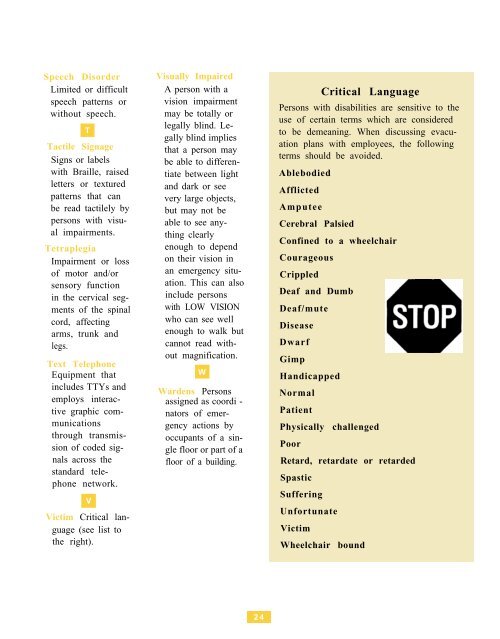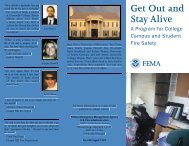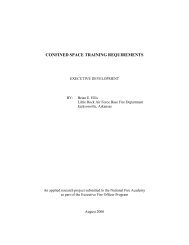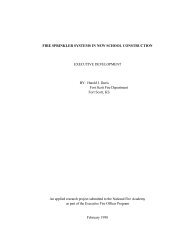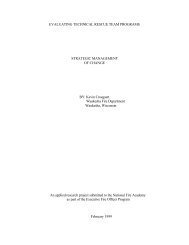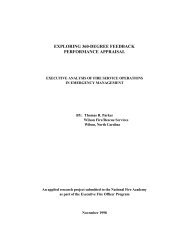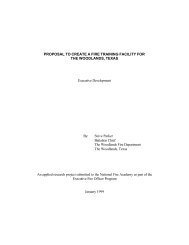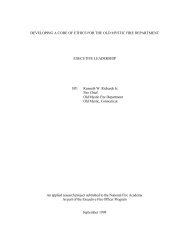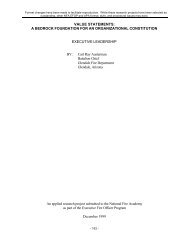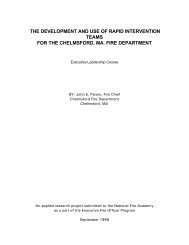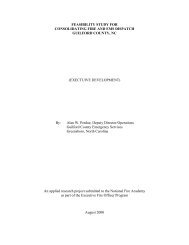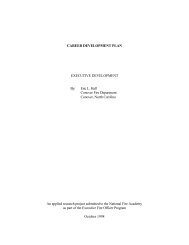Emergency Procedures for Employees with Disabilities - US Fire ...
Emergency Procedures for Employees with Disabilities - US Fire ...
Emergency Procedures for Employees with Disabilities - US Fire ...
You also want an ePaper? Increase the reach of your titles
YUMPU automatically turns print PDFs into web optimized ePapers that Google loves.
Speech Disorder<br />
Limited or difficult<br />
speech patterns or<br />
<strong>with</strong>out speech.<br />
T<br />
Tactile Signage<br />
Signs or labels<br />
<strong>with</strong> Braille, raised<br />
letters or textured<br />
patterns that can<br />
be read tactilely by<br />
persons <strong>with</strong> visual<br />
impairments.<br />
Tetraplegia<br />
Impairment or loss<br />
of motor and/or<br />
sensory function<br />
in the cervical segments<br />
of the spinal<br />
cord, affecting<br />
arms, trunk and<br />
legs.<br />
Text Telephone<br />
Equipment that<br />
includes TTYs and<br />
employs interactive<br />
graphic communications<br />
through transmission<br />
of coded signals<br />
across the<br />
standard telephone<br />
network.<br />
V<br />
Victim Critical language<br />
(see list to<br />
the right).<br />
Visually Impaired<br />
A person <strong>with</strong> a<br />
vision impairment<br />
may be totally or<br />
legally blind. Legally<br />
blind implies<br />
that a person may<br />
be able to differentiate<br />
between light<br />
and dark or see<br />
very large objects,<br />
but may not be<br />
able to see anything<br />
clearly<br />
enough to depend<br />
on their vision in<br />
an emergency situation.<br />
This can also<br />
include persons<br />
<strong>with</strong> LOW VISION<br />
who can see well<br />
enough to walk but<br />
cannot read <strong>with</strong>out<br />
magnification.<br />
W<br />
Wardens Persons<br />
assigned as coordi -<br />
nators of emergency<br />
actions by<br />
occupants of a single<br />
floor or part of a<br />
floor of a building.<br />
24<br />
Critical Language<br />
Persons <strong>with</strong> disabilities are sensitive to the<br />
use of certain terms which are considered<br />
to be demeaning. When discussing evacuation<br />
plans <strong>with</strong> employees, the following<br />
terms should be avoided.<br />
Ablebodied<br />
Afflicted<br />
Amputee<br />
Cerebral Palsied<br />
Confined to a wheelchair<br />
Courageous<br />
Crippled<br />
Deaf and Dumb<br />
Deaf/mute<br />
Disease<br />
Dwarf<br />
Gimp<br />
Handicapped<br />
Normal<br />
Patient<br />
Physically challenged<br />
Poor<br />
Retard, retardate or retarded<br />
Spastic<br />
Suffering<br />
Un<strong>for</strong>tunate<br />
Victim<br />
Wheelchair bound


